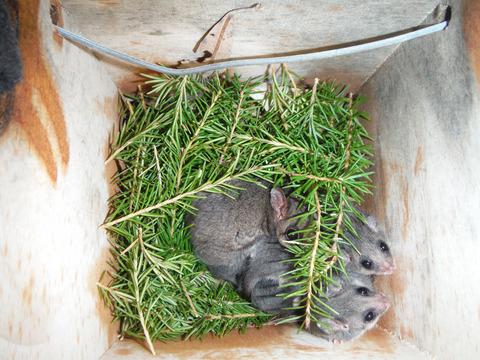Our official English website, www.x-mol.net, welcomes your
feedback! (Note: you will need to create a separate account there.)
Sex and age differences in tree cavity dependence in a small arboreal marsupial
Journal of Zoology ( IF 1.9 ) Pub Date : 2020-05-18 , DOI: 10.1111/jzo.12793 R. L. Goldingay 1
Journal of Zoology ( IF 1.9 ) Pub Date : 2020-05-18 , DOI: 10.1111/jzo.12793 R. L. Goldingay 1
Affiliation

|
Many mammal species depend on tree cavities for shelter and for breeding. Some species may use tree cavities as well as other varied shelters, but the extent of their dependence on tree cavities is unknown. One such species is the eastern pygmy‐possum (Cercartetus nanus) from eastern Australia which typically shelters alone. Four key questions were addressed: (1) do different age and sex classes differ in their preferences for small (4 cm diameter) and large (10 cm diameter) cavities, (2) does the availability of large cavities influence female breeding status, (3) does the availability of large cavities influence where adult females and males are detected, and (4) does the availability of large cavities influence survival and abundance? Two 9‐ha plots containing few (≤2 per ha) ‘large’ natural cavities were provisioned with artificial cavities in different years. When plots were provisioned with small and large cavities, breeding females (n = 46) showed a pronounced preference for sheltering in the large cavities while adult males (n = 67) and subadults (n = 40) preferred the small cavities. When one plot and not the other was provisioned with large cavities, adult females were significantly more likely to be reproductive and be detected on the plot with large cavities, but survival was not influenced. Detection of adult males did not vary with large cavity provisioning. The abundance of adult pygmy‐possums varied among years, being higher on the plot provisioned with large cavities when the other plot was not provisioned, but equivalent when both were provisioned. The findings of this study are consistent with the hypothesis that breeding females are dependent on a large cavity to raise a litter. Other mammal species around the world are likely to exhibit similar but currently unrecognized shelter site strategies which have implications for their management.
中文翻译:

小型有树有袋动物的树洞依赖性的性别和年龄差异
许多哺乳动物物种都依赖树洞进行庇护和繁殖。一些物种可能会使用树洞以及其他各种庇护所,但是它们对树洞的依赖性程度尚不清楚。其中一种是东部侏儒负鼠(Cercartetus nanus))来自澳大利亚东部地区,通常通常是单独避难所。解决了四个关键问题:(1)不同年龄和性别类别对小(直径4厘米)和大(直径10厘米)腔的偏好是否不同,(2)大腔的可用性是否会影响雌性繁殖状态,( 3)大洞的可利用性是否会影响到成年雌性和雄性被发现的地方;(4)大洞的可利用性会影响生存和丰度吗?在不同年份为两个包含少量(≤2个/公顷)“大”天然洞的9公顷土地提供了人工洞。当给小区提供小型和大型蛀牙时,繁殖的雌性(n = 46)在大型蛀牙中表现出明显的躲避能力,而成年雄性(n = 46) = 67)和亚成人(n = 40)首选小孔。当一个地块而不是另一个地块被提供了大洞时,成年雌性繁殖的可能性更高,并且在具有大洞的地块上被检测到,但是存活率没有受到影响。成年男性的检出率与大孔配置无关。成年侏儒负鼠的数量随着年份的变化而变化,在未配置其他地块的大洞地块上,该地块的配置更高,而在同时配置两个地块的地块上,地势则更高。这项研究的结果与这样的假设相吻合,即繁殖的雌性依赖于大窝来产仔。世界其他地区的哺乳动物很可能会表现出相似但目前未被认可的庇护所策略,这对其管理产生了影响。
更新日期:2020-05-18
中文翻译:

小型有树有袋动物的树洞依赖性的性别和年龄差异
许多哺乳动物物种都依赖树洞进行庇护和繁殖。一些物种可能会使用树洞以及其他各种庇护所,但是它们对树洞的依赖性程度尚不清楚。其中一种是东部侏儒负鼠(Cercartetus nanus))来自澳大利亚东部地区,通常通常是单独避难所。解决了四个关键问题:(1)不同年龄和性别类别对小(直径4厘米)和大(直径10厘米)腔的偏好是否不同,(2)大腔的可用性是否会影响雌性繁殖状态,( 3)大洞的可利用性是否会影响到成年雌性和雄性被发现的地方;(4)大洞的可利用性会影响生存和丰度吗?在不同年份为两个包含少量(≤2个/公顷)“大”天然洞的9公顷土地提供了人工洞。当给小区提供小型和大型蛀牙时,繁殖的雌性(n = 46)在大型蛀牙中表现出明显的躲避能力,而成年雄性(n = 46) = 67)和亚成人(n = 40)首选小孔。当一个地块而不是另一个地块被提供了大洞时,成年雌性繁殖的可能性更高,并且在具有大洞的地块上被检测到,但是存活率没有受到影响。成年男性的检出率与大孔配置无关。成年侏儒负鼠的数量随着年份的变化而变化,在未配置其他地块的大洞地块上,该地块的配置更高,而在同时配置两个地块的地块上,地势则更高。这项研究的结果与这样的假设相吻合,即繁殖的雌性依赖于大窝来产仔。世界其他地区的哺乳动物很可能会表现出相似但目前未被认可的庇护所策略,这对其管理产生了影响。











































 京公网安备 11010802027423号
京公网安备 11010802027423号